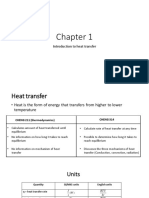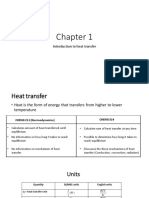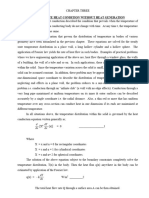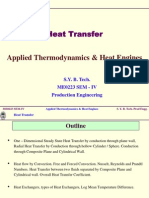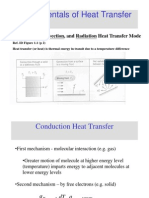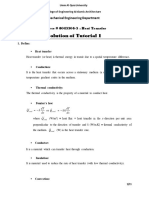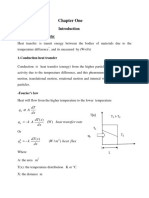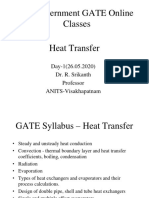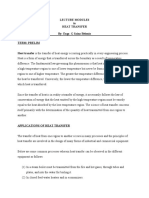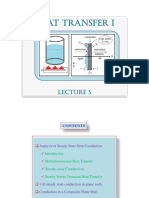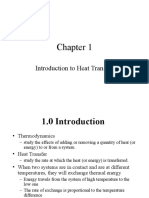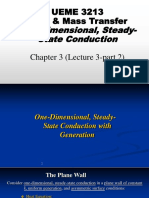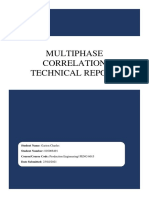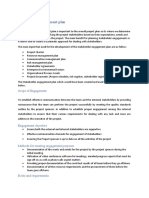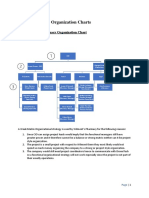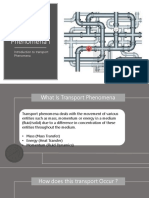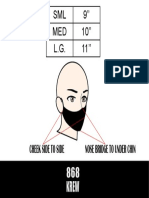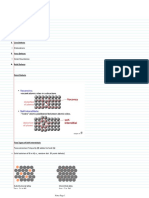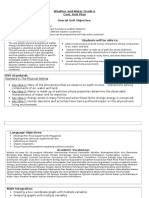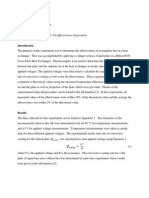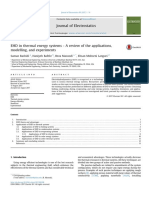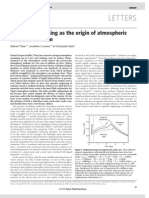4.
Intro to Heat Transfer and Heat Diffusion Equation
The Transfer of energy in the form of heat occurs in many chemical and other types of
processes. Heat transfer often occurs in combination with other separation processes, such as
drying of lumber or foods, alcohol distillation, burning of fuel, an evaporation. The heat
transfer occurs because of a temperature-difference diving force and the heat flows from the
high to the low-temperature region.
4.1. Mechanisms of heat transfer
4.1.1. Conduction
𝑑𝑇
[ 𝑞𝑥 = −𝐾𝐴 ] 𝐹𝑜𝑢𝑟𝑖𝑒𝑟 ′ 𝑠 𝐿𝑎𝑤
𝑑𝑥
qx – heat transfer rate (W or J/s)
K – Thermal conductivity of material (W/m ℃ or W/ m k)
A- Area of surface (m2)
𝑑𝑇
– Temperature gradient (℃/m or k/m)
𝑑𝑥
Page | 22
�Example 1
The inner and the outer surface of a 5m x 6m brick wall of thickness 30 cm and thermal
conductivity 0.69 w/ m℃ are maintained at 20℃ and 5℃. What is the rate of heat transfer
through the wall?
Using Fourier’s Law
(5 − 20)
𝑞𝑥 = −(0.69)(5 × 6) = 1035 𝑊
0.3
4.1.2. Convection
Heat transfer due to both random motion and by bulk or macroscopic motion of the fluid.
Forced Convection – Fluid is moved by some mechanical means e.g. (Blower, Pump)
Free or Natural Convection – Buoyancy forces alone move the fluid.
Page | 23
�4.1.3. Convection Rate Equation
[ 𝑞 = ℎ𝐴(𝑇𝑤 − 𝑇∞ )] 𝑁𝑒𝑤𝑡𝑜𝑛′ 𝑠 𝐿𝑎𝑤 𝑜𝑓 𝐶𝑜𝑜𝑙𝑖𝑛𝑔
q – Heat transfer rate (W or J/s)
h – Convective heat transfer coefficient (W/m2k)
A – Surface or exposed area (m2)
Tw – Wall Temperature (℃o or k)
T∞ - Freestream fluid temperature (℃ or k)
Usually use to help determine h
Example 2
Hot air at T = 150℃ flows over a flat plate maintained at T =50℃. The forced heat transfer
coefficient is h = 75 W/m2℃. Calculate the heat transfer rate into the plate through an area of
2m2.
𝑞 = (75)(2)(50 − 150) = −15 𝐾𝑊
𝑞 = 15 𝐾𝑊 𝑖𝑛𝑡𝑜 𝑡ℎ𝑒 𝑝𝑙𝑎𝑡𝑒
4.2. Surface Energy Balance
Consider the following scenario at the surface medium
Page | 24
�Conservation of energy across control surface
[ 𝑞𝑖𝑛 − 𝑞𝑜𝑢𝑡 = 0 ]
[ 𝑞𝑐𝑜𝑛𝑑 − 𝑞𝑐𝑜𝑛𝑣 − 𝑞𝑟𝑎𝑑 = 0 ]
Example 1
Hot combustion gases in a furnace, separated from the ambient at 25℃, by a 0.15m thick brick
with thermal conductivity of 1.2 W/m K and surface emissivity of 0.8 under steady-state
conditions, outer temp measured at 100℃ free convection to air from the brick convection heat
transfer coefficient h = 20 W/m2℃ what is the brick inner wall temperature?
Assume:
1. Steady State
2. 1-D Conduction through wall
3. Surroundings large compared to brick wall
4. Grey Surface
Using the second equation for surface energy balance
𝑇𝑠 − 𝑇1
−𝐾𝐴 ( ) = ℎ𝐴(𝑇𝑠 − 𝑇∞ ) + 𝜀𝐴𝜎(𝑇𝑠 4 − 𝑇𝑠𝑢𝑟𝑟 4 )
𝐿
𝐿ℎ 𝐿𝜀𝜎 4
𝑇1 = 𝑇𝑠 + (𝑇𝑠 − 𝑇∞ ) + (𝑇𝑠 − 𝑇𝑠𝑢𝑟𝑟 4 )
𝐾 𝐾
(0.15)(20) (0.15)(0.8)(5.67 × 10−8 )
𝑇1 = 100 + (100 − 25) + (3734 − 2984 )
1.2 1.2
𝑇1 = 352.5℃
Page | 25
�4.3. Heat Diffusion Equation (Heat Equation)
A main objective behind conduction analysis is to determine the TEMPERATURE
DISTRIBUTION 𝑇(𝑥, 𝑦, 𝑧, 𝑡) in a medium knowing temperature, and/or heat transfer rates on
the surface we derive the HEAT DIFFUSION EQUATION for this purpose.
𝑑𝑇 𝜕𝑇
𝑞𝑥 = −𝐾𝐴 𝑑𝑥 = −𝐾𝑑𝑦(1) 𝜕𝑥
𝜕𝑇
𝜕(𝑞𝑥 ) 𝜕(−𝐾𝑑𝑦(1) )
𝜕𝑥
𝑞𝑥+𝑑𝑥 = 𝑞𝑥 + 𝑑𝑥 = 𝑞𝑥 + 𝑑𝑥
𝜕𝑥 𝜕𝑥
𝑑𝑇 𝜕𝑇
𝑞𝑦 = −𝐾𝐴 𝑑𝑦 = −𝐾𝑑𝑥(1) 𝜕𝑦
𝜕𝑇
𝜕(𝑞𝑦 ) 𝜕(−𝐾𝑑𝑥(1) )
𝜕𝑦
𝑞𝑦+𝑑𝑦 = 𝑞𝑦 + 𝑑𝑦 = 𝑞𝑦 + 𝑑𝑦
𝜕𝑦 𝜕𝑦
𝐸̇𝑔 = 𝑞̇ (𝑣𝑜𝑙) = 𝑞̇ 𝑑𝑥𝑑𝑦
𝜕𝑇 𝜕𝑇 𝜕𝑇
𝐸̇𝑠𝑡 = 𝑚𝑐𝑝 𝜕𝑡 = 𝜌𝑐𝑝 (𝑣𝑜𝑙) 𝜕𝑡 = 𝜌𝑐𝑝 𝑑𝑥𝑑𝑦 𝜕𝑡
Energy Balance
𝐸̇𝑖𝑛 − 𝐸̇𝑜𝑢𝑡 + 𝐸̇𝑔 = 𝐸̇𝑠𝑡
𝜕 2 𝑇 𝜕 2 𝑇 𝜕 2 𝑇 𝑞̇ 1 𝜕𝑇
[ 2
+ 2+ 2+ = ]
𝜕𝑥 𝜕𝑦 𝜕𝑧 𝐾 𝛼 𝜕𝑡
Page | 26
�4.3.1. Common Boundary Conditions
Consider 1-D on the surface
1. Constant surface temperature
T (x = 0, t) = Ts
(e.g. an ice bath)
2. Constant Surface Heat Flux
(a) Finite heat flux
𝑞𝑥 𝜕𝑇
= −𝐾 𝜕𝑥 |
𝐴 𝑥=0
(e.g. an electrical heater)
(b) Adiabatic or insulate surface
𝑞𝑥 𝜕𝑇
= 0 = 𝜕𝑥 |
𝐴 𝑥=0
3. Convective Surface Condition
𝑞𝑥 𝜕𝑇
= −𝐾 𝜕𝑥 | = ℎ[𝑇∞ − 𝑇 (0, 𝑡)]
𝐴 𝑥=0
Page | 27
�4.4. Alternative Method
This Method is only valid if:
Steady-State Conduction
One-Dimensional Conduction
No heat generation
𝑑𝑇
𝑞𝑥 = −𝐾𝐴
𝑑𝑥
𝑑𝑥
𝑞𝑥 = −𝐾(𝑇)𝑑𝑇
𝐴(𝑥)
𝑥 𝑇
𝑑𝑥
𝑞𝑥 ∫ = − ∫ 𝐾(𝑇)𝑑𝑇
𝑥0 𝐴(𝑥) 𝑇𝑜
Assuming that the thermal Conductivity is independent of temperature i.e. it is constant
𝑥 𝑇
𝑑𝑥
[ 𝑞𝑥 ∫ = −𝐾 ∫ 𝑑𝑇 ]
𝑥0 𝐴(𝑥) 𝑇𝑜
Page | 28
�Example 1 (Conical Section)
Conical section made from pyro Ceram (K=3.46 W/m.K). Circular cross section with D = ax
where a = 0.25. Small end is at x1 = 50 mm and the large end is at x2 = 250 mm End
temperatures are T1 = 400 k and T2 = 600 k, lateral surface is well insulated.
1. Derive and analytic expression for T(x) in the cone
2. Compute the heat transfer rate qx
𝑑𝑇
𝑞𝑥 = −𝐾𝐴
𝑑𝑥
𝜋𝐷2 𝜋𝑎2 𝑥 2
𝐴= =
4 4
4𝑞𝑥
𝑑𝑥 = −𝐾𝑑𝑇
𝜋𝑎2 𝑥 2
Integrate between x1 and any x:
𝑥 𝑇
4𝑞𝑥 𝑑𝑥
∫ = −𝐾 ∫ 𝑑𝑇
𝜋𝑎2 𝑥 2
𝑥1 𝑇1
4𝑞𝑥 1 1
[− + ] = −𝐾(𝑇 − 𝑇1 )
𝜋𝑎2 𝑥 𝑥1
Solve for T(x):
4𝑞𝑥 1 1
[ 𝑇(𝑥) = 𝑇1 − [ − ] ]
𝜋𝑎2 𝐾 𝑥1 𝑥
We know T(x2) = T2
𝜋𝑎2 𝐾(𝑇1 − 𝑇2 )
𝑞𝑥 =
1 1
4 (𝑥 − 𝑥 )
1 2
q = -2.12 W from x2 to x1
Page | 29
�Example 2 (Cylindrical System) Radial conduction
𝐴 = 2𝜋𝑟𝐿
𝑑𝑇
𝑞𝑟 = −𝐾𝐴
𝑑𝑟
𝑞𝑟
𝑑𝑟 = −𝐾𝑑𝑇
2𝜋𝑟𝐿
Integrating between ri and any r :
𝑟 𝑇
𝑞𝑟 𝑑𝑟
∫ = −𝐾 ∫ 𝑑𝑇
2𝜋𝐿 𝑟
𝑟𝑖 𝑇𝑖
𝑞𝑟 𝑟
𝑇(𝑟) = 𝑇𝑖 − ln ( )
2𝜋𝑟𝐿𝐾 𝑟𝑖
T(ro) = To :
𝑞𝑟 𝑟𝑜
𝑇𝑜 = 𝑇𝑖 − ln ( )
2𝜋𝑟𝐿𝐾 𝑟𝑖
2𝜋𝐿𝐾(𝑇𝑖 − 𝑇𝑜 )
[ 𝑞𝑟 = 𝑟 ]
ln ( 𝑟0 )
𝑖
Page | 30
�Example 3 (Spherical System) Spherical Conduction
𝐴 = 4𝜋𝑟 2 𝑓𝑜𝑟 𝑆ℎ𝑝𝑒𝑟𝑖𝑐𝑎𝑙 𝑎𝑟𝑒𝑎
𝑑𝑇
𝑞𝑟 = −𝐾𝐴
𝑑𝑟
𝑞𝑟
𝑑𝑟 = −𝐾𝑑𝑇
4𝜋𝑟 2
Integrating between ri and any r:
𝑟 𝑇
𝑞𝑟 𝑑𝑟
∫ = −𝐾 ∫ 𝑑𝑇
4𝜋 𝑟 2
𝑟𝑖 𝑇𝑖
𝑞𝑟 1 1
[− + ] = −𝐾[𝑇 − 𝑇𝑖 ]
4𝜋 𝑟 𝑟𝑖
𝑞𝑟 1 1
𝑇(𝑟) = 𝑇𝑖 − [ − ]
4𝜋𝐾 𝑟𝑖 𝑟
We Know T (ro) = To:
4𝜋𝐾(𝑇𝑖 − 𝑇𝑜 )
[ 𝑞𝑟 = ]
1 1
(𝑟 − 𝑟 )
𝑖 𝑜
Page | 31




